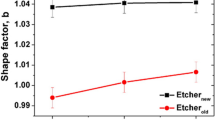Abstract
Induction-coupled plasma deposition (ICPD) is currently a laboratory process relying on operator expertise rather than automated control. Intelligent process control for the ICPD process, which consists of integration of processing knowledge, process models, process sensors and control technology, offers the opportunity to provide closed-loop control as well as intelligent supervisory control to accelerate process development and bring the ICPD process to full-scale production. Intelligent process control for ICPD offers benefits such as higher material quality, control of the matrix micro-structure, cost reduction, higher process yield, and shorter development and production cycle times.
Similar content being viewed by others
References
P.A. Parrish and W.G. Barker, “The Basics of the Intelligent Processing of Materials,” JOM, 42(7) (July 1990), pp. 14–16.
D. Backman, “Metal-Matrix Composites and IPM: A Modeling Perspective,” JOM, 42(7) (July 1990), pp. 17–20.
R.D. Lillquist and C.M. Penny, “Arc-Welding Seam-Tracking Applications Employing Passive Infrared Sensors,” U.S. patent no. 4,477,712 (October 16, 1984).
R.D. Lillquist, “Infrared Sensor for Arc-Welding,” U.S. patent no. 4,484,059 (November 20, 1984).
R.D. Lillquist, “Imaging Pyrometer,” U.S. patent no. 4,687,344, (August 18, 1987) and Certificate of Correction/April 26, 1988).
R.D. Lillquist, R. Lober and R.G. Menzies, “Infrared Sensor for the Control of Plasma Jet Spray Coating Processes and Electric Arc Heating Processes,” U.S. patent no. 4,656,331 (April 7, 1987).
H.P. Wang, E.M. Perry and R.D. Lillquist, “Intelligent Processing of Materials for Plasma Deposition,” Symposium M—Plasma Processing and Synthesis of Materials, Materials Research Society, San Francisco, CA (1990).
D. Wei, B. Farouk and D. Apelian, “Melting Metal Powder Particles in an Inductively Coupled RF Plasma Torch,” Met. Trans. B, 19B (1988), pp. 213–226.
H.P. Wang and E.M. Perry, “A Fast-Acting Process Simulator for Intelligent Plasma Deposition,” Transport Phenomena in Material Processing, HTD-vol. 132, ed. M. Charmichi, M.K. Chyu, Y. Joshi and S.M. Walsh (New York: ASME, 1990), pp. 99–108.
D. Backman, E. Russell, D. Wei and Y. Pang, “Intelligent Processing for Metal Matrix Composites,” Intelligent Processing of Materials, ed. H.N.G. Wadley and W.E. Eckhart, Jr. (Warrendale, PA: TMS, 1990), pp. 17–39.
Author information
Authors and Affiliations
Rights and permissions
About this article
Cite this article
Wang, H.P., Perry, E.M., Lillquist, R.D. et al. Elements of intelligent process control for plasma deposition. JOM 43, 22–25 (1991). https://doi.org/10.1007/BF03220113
Issue Date:
DOI: https://doi.org/10.1007/BF03220113




